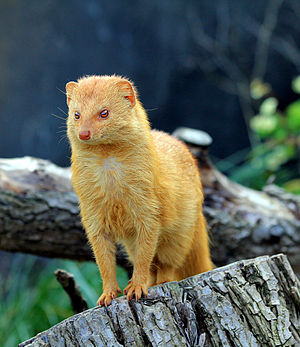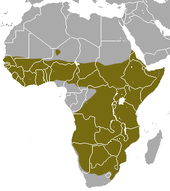Slim mongoose
| Slim mongoose | ||||||||||||
|---|---|---|---|---|---|---|---|---|---|---|---|---|

Slender mongoose ( Galerella sanguinea ) |
||||||||||||
| Systematics | ||||||||||||
|
||||||||||||
| Scientific name | ||||||||||||
| Galerella sanguinea | ||||||||||||
| ( Rüppell , 1836) |
The slender mongoose ( Galerella sanguinea , syn .: Herpestes sanguineus ) is a predator of the mongoose family (Herpestidae) with a wide distribution in Africa .
features
This mongoose reaches a head-body length of 27.5 to 40 cm and a tail length of 23 to 33 cm. The males weigh about 640 to 715 g, the smaller females only reach 460 to 575 g.
The fur color varies greatly depending on the subspecies between dark red-brown, orange-red, gray and yellowish. The slender mongoose differs from other mongooses by the striking black or red tip of the tail. The first upper premolars are often stunted and sometimes absent entirely.
distribution and habitat
The slender mongoose has a wide distribution area in sub- Saharan Africa . It is only absent in the southern half of South Africa and in the dense forests of Equatorial Africa . Furthermore, she avoids real deserts . Preferred habitats are savannahs and other semi-arid regions.
Way of life
This mongoose lives either alone or in pairs. It is basically diurnal, but also searches for food on warm moonlit nights. The species presumably has no demarcated territories, but it stays in the same territory all the time, which it often shares with other mongooses or crawling cats . The different species often use the same burrow, as the related species, in contrast to the slender mongoose, are mostly nocturnal. Burrows can be dug or created in layers of earth between rocks, in tree hollows or between roots as well as in abandoned burrows of other animals and in similar places.
food
As the main carnivore , the slender mongoose feeds on smaller invertebrates and vertebrates such as insects , lizards , frogs , snakes , rodents and birds . To a lesser extent, it consumes fruit. Furthermore, eggs and carrion are eaten. Like many other mongooses, the slender mongoose is able to kill poisonous snakes , which, however, only make up a small part of their diet. The slender mongoose climbs more than their relatives in trees and bushes to catch birds.
Reproduction
The territory of a male usually overlaps with the territories of several females and the announcement of the willingness to mate occurs via fragrances. After a gestation of probably 60 to 70 days, the female gives birth to one to three young (mostly twins). The male does not take part in the rearing of the offspring. After an average of one year, the young become sexually mature. The maximum age is assumed to be 10 years.
hazards
The species is occasionally sold as bushmeat on local markets and is used in traditional medicine in individual cases. Due to the large distribution area in which several nature reserves have been established, these phenomena do not affect the population. The IUCN lists the slender mongoose as not endangered (LC).
Individual evidence
- ↑ a b c d e A. Tislerics: Galerella sanguinea ( English ) In: Animal Diversity Web . University of Michigan ,. 2000. Retrieved December 3, 2011.
- ↑ a b Herpestes sanguineus in the Red List of Threatened Species of the IUCN 2011. Posted by: Hoffmann, M., 2008. Retrieved on December 3, 2011.
Web links
- Slim mongoose on tierdoku.com
- WildlifeSafari.info identification guide (English)
